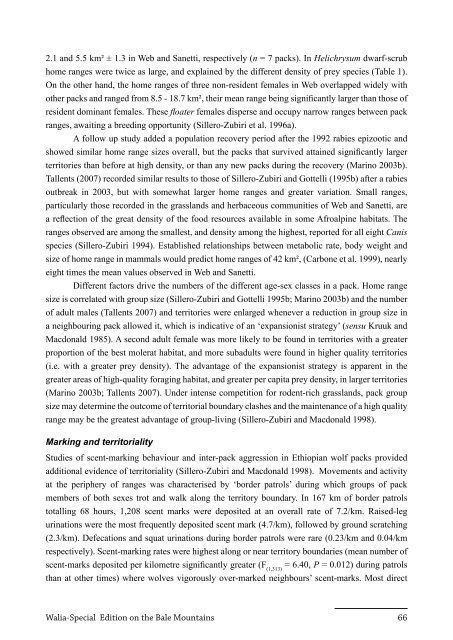Walia Special Edition on the Bale Mountains (2011) - Zoologische ...
Walia Special Edition on the Bale Mountains (2011) - Zoologische ...
Walia Special Edition on the Bale Mountains (2011) - Zoologische ...
You also want an ePaper? Increase the reach of your titles
YUMPU automatically turns print PDFs into web optimized ePapers that Google loves.
2.1 and 5.5 km² ± 1.3 in Web and Sanetti, respectively (n = 7 packs). In Helichrysum dwarf-scrub<br />
home ranges were twice as large, and explained by <strong>the</strong> different density of prey species (Table 1).<br />
On <strong>the</strong> o<strong>the</strong>r hand, <strong>the</strong> home ranges of three n<strong>on</strong>-resident females in Web overlapped widely with<br />
o<strong>the</strong>r packs and ranged from 8.5 - 18.7 km², <strong>the</strong>ir mean range being significantly larger than those of<br />
resident dominant females. These floater females disperse and occupy narrow ranges between pack<br />
ranges, awaiting a breeding opportunity (Sillero-Zubiri et al. 1996a).<br />
A follow up study added a populati<strong>on</strong> recovery period after <strong>the</strong> 1992 rabies epizootic and<br />
showed similar home range sizes overall, but <strong>the</strong> packs that survived attained significantly larger<br />
territories than before at high density, or than any new packs during <strong>the</strong> recovery (Marino 2003b).<br />
Tallents (2007) recorded similar results to those of Sillero-Zubiri and Gottelli (1995b) after a rabies<br />
outbreak in 2003, but with somewhat larger home ranges and greater variati<strong>on</strong>. Small ranges,<br />
particularly those recorded in <strong>the</strong> grasslands and herbaceous communities of Web and Sanetti, are<br />
a reflecti<strong>on</strong> of <strong>the</strong> great density of <strong>the</strong> food resources available in some Afroalpine habitats. The<br />
ranges observed are am<strong>on</strong>g <strong>the</strong> smallest, and density am<strong>on</strong>g <strong>the</strong> highest, reported for all eight Canis<br />
species (Sillero-Zubiri 1994). Established relati<strong>on</strong>ships between metabolic rate, body weight and<br />
size of home range in mammals would predict home ranges of 42 km², (Carb<strong>on</strong>e et al. 1999), nearly<br />
eight times <strong>the</strong> mean values observed in Web and Sanetti.<br />
Different factors drive <strong>the</strong> numbers of <strong>the</strong> different age-sex classes in a pack. Home range<br />
size is correlated with group size (Sillero-Zubiri and Gottelli 1995b; Marino 2003b) and <strong>the</strong> number<br />
of adult males (Tallents 2007) and territories were enlarged whenever a reducti<strong>on</strong> in group size in<br />
a neighbouring pack allowed it, which is indicative of an ‘expansi<strong>on</strong>ist strategy’ (sensu Kruuk and<br />
Macd<strong>on</strong>ald 1985). A sec<strong>on</strong>d adult female was more likely to be found in territories with a greater<br />
proporti<strong>on</strong> of <strong>the</strong> best molerat habitat, and more subadults were found in higher quality territories<br />
(i.e. with a greater prey density). The advantage of <strong>the</strong> expansi<strong>on</strong>ist strategy is apparent in <strong>the</strong><br />
greater areas of high-quality foraging habitat, and greater per capita prey density, in larger territories<br />
(Marino 2003b; Tallents 2007). Under intense competiti<strong>on</strong> for rodent-rich grasslands, pack group<br />
size may determine <strong>the</strong> outcome of territorial boundary clashes and <strong>the</strong> maintenance of a high quality<br />
range may be <strong>the</strong> greatest advantage of group-living (Sillero-Zubiri and Macd<strong>on</strong>ald 1998).<br />
Marking and territoriality<br />
Studies of scent-marking behaviour and inter-pack aggressi<strong>on</strong> in Ethiopian wolf packs provided<br />
additi<strong>on</strong>al evidence of territoriality (Sillero-Zubiri and Macd<strong>on</strong>ald 1998). Movements and activity<br />
at <strong>the</strong> periphery of ranges was characterised by ‘border patrols’ during which groups of pack<br />
members of both sexes trot and walk al<strong>on</strong>g <strong>the</strong> territory boundary. In 167 km of border patrols<br />
totalling 68 hours, 1,208 scent marks were deposited at an overall rate of 7.2/km. Raised-leg<br />
urinati<strong>on</strong>s were <strong>the</strong> most frequently deposited scent mark (4.7/km), followed by ground scratching<br />
(2.3/km). Defecati<strong>on</strong>s and squat urinati<strong>on</strong>s during border patrols were rare (0.23/km and 0.04/km<br />
respectively). Scent-marking rates were highest al<strong>on</strong>g or near territory boundaries (mean number of<br />
scent-marks deposited per kilometre significantly greater (F = 6.40, P = 0.012) during patrols<br />
(1,313)<br />
than at o<strong>the</strong>r times) where wolves vigorously over-marked neighbours’ scent-marks. Most direct<br />
<str<strong>on</strong>g>Walia</str<strong>on</strong>g>-<str<strong>on</strong>g>Special</str<strong>on</strong>g> <str<strong>on</strong>g>Editi<strong>on</strong></str<strong>on</strong>g> <strong>on</strong> <strong>the</strong> <strong>Bale</strong> <strong>Mountains</strong> 66
















